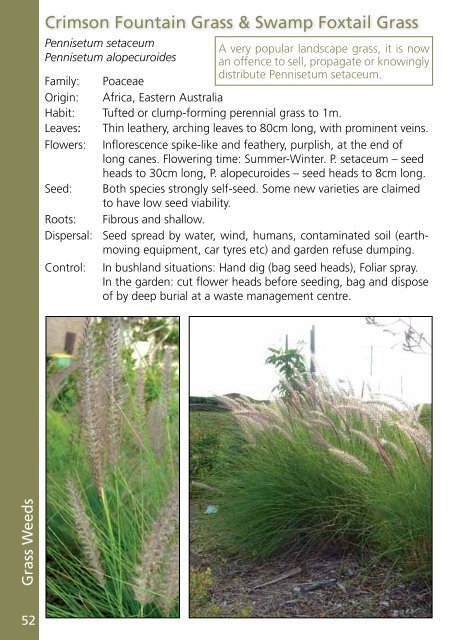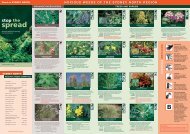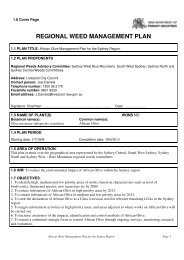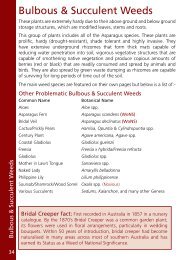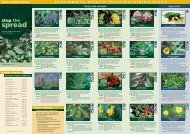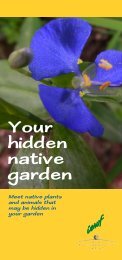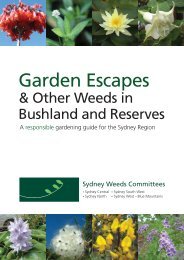Crimson Fountain Grass & Swamp Foxtail Grass - Sydney Weeds ...
Crimson Fountain Grass & Swamp Foxtail Grass - Sydney Weeds ...
Crimson Fountain Grass & Swamp Foxtail Grass - Sydney Weeds ...
Create successful ePaper yourself
Turn your PDF publications into a flip-book with our unique Google optimized e-Paper software.
<strong>Crimson</strong> <strong>Fountain</strong> <strong>Grass</strong> & <strong>Swamp</strong> <strong>Foxtail</strong> <strong>Grass</strong><br />
Pennisetum setaceum<br />
Pennisetum alopecuroides<br />
Family:<br />
Origin:<br />
Habit:<br />
Leaves:<br />
Flowers:<br />
Seed:<br />
Roots:<br />
Dispersal:<br />
Control:<br />
A very popular landscape grass, it is now<br />
an offence to sell, propagate or knowingly<br />
distribute Pennisetum setaceum.<br />
Poaceae<br />
Africa, Eastern Australia<br />
Tufted or clump-forming perennial grass to 1m.<br />
Thin leathery, arching leaves to 80cm long, with prominent veins.<br />
Inflorescence spike-like and feathery, purplish, at the end of<br />
long canes. Flowering time: Summer-Winter. P. setaceum – seed<br />
heads to 30cm long, P. alopecuroides – seed heads to 8cm long.<br />
Both species strongly self-seed. Some new varieties are claimed<br />
to have low seed viability.<br />
Fibrous and shallow.<br />
Seed spread by water, wind, humans, contaminated soil (earthmoving<br />
equipment, car tyres etc) and garden refuse dumping.<br />
In bushland situations: Hand dig (bag seed heads), Foliar spray.<br />
In the garden: cut flower heads before seeding, bag and dispose<br />
of by deep burial at a waste management centre.<br />
<strong>Grass</strong> <strong>Weeds</strong><br />
52
Liriope/Lily Turf<br />
Liriope spp.<br />
Family:<br />
Origin:<br />
Habit:<br />
Leaves:<br />
Flowers:<br />
Fruit:<br />
Roots:<br />
Dispersal:<br />
Control:<br />
This is a very popular garden plant that<br />
is used extensively in landscaping for its<br />
hardiness in extreme conditions. It is just<br />
starting to become a problem in shaded<br />
Ruscaceae riparian areas.<br />
East Asia<br />
Clump forming and spreading, grass like perennial lily.<br />
Glossy dark green, narrow straplike, dense linear foliage from<br />
20-50cm long and then recurves toward the ground to form<br />
rounded clumps.<br />
Spikes of small purple, violet or white flowers rise from the<br />
center of clumps.<br />
Black, pea sized berries, each containing one seed.<br />
Dense, fibrous root mass. Some species develop fleshy tubers.<br />
Seed spread by water and humans via contaminated soil and<br />
garden refuse dumping. Spread locally by seed falling from plant<br />
and rhizomes<br />
In bushland situations: Hand dig (bag seed heads), Foliar spray.<br />
In the garden: cut flower heads before seeding, bag and dispose<br />
of by deep burial at a waste management centre.<br />
Active management is neccesary in all garden situations to prevent this plant<br />
from degrading bushland.<br />
<strong>Grass</strong> <strong>Weeds</strong><br />
53
Pampas <strong>Grass</strong><br />
Cortaderia spp.<br />
Family:<br />
Origin:<br />
Habit:<br />
Leaves:<br />
Flowers:<br />
Seed:<br />
Roots:<br />
Dispersal:<br />
Control:<br />
A very popular garden plant in the 1960’s<br />
and 1970’s, Pampas <strong>Grass</strong> has earned its<br />
status as a declared noxious weed.<br />
Poaceae<br />
South America and New Zealand<br />
Large, long lived perennial tussock forming ornamental grass<br />
to 4.5m tall.<br />
Light green, up to 2m long and finely tapering with prominent<br />
midrib and sharp edges that will cut the skin. A rim of hairs (to<br />
3mm long) at leaf base (ligule).<br />
Large feathery heads on stems to 3m tall. White-biege<br />
(C. selloana), or pink-mauve (C. jubata). Up to 50 plumes<br />
formed on one mature plant. Both single sex and bisexual plants<br />
exist. Summer-Winter.<br />
Small (2mm), short-lived, up to 100,000 seeds set per plume.<br />
Strong fibrous root with rhizomes capable of re-shooting.<br />
Seed spread by water, wind, humans, contaminated soil<br />
(earthmoving equipment, car tyres etc) and garden<br />
refuse dumping.<br />
Crowning, Slash and hand dig with mattock, Foliar spray.<br />
Bag all seed heads.<br />
<strong>Grass</strong> <strong>Weeds</strong><br />
54
Panic Veldt <strong>Grass</strong><br />
Ehrharta erecta<br />
Family:<br />
Origin:<br />
Habit:<br />
Leaves:<br />
Flowers:<br />
Seed:<br />
Roots:<br />
Dispersal:<br />
Control:<br />
Poaceae<br />
South Africa<br />
An aggressive, perennial grass almost<br />
constantly in seed, Ehrharta spreads rapidly<br />
excluding many small native ground cover<br />
species. Similar Native Species: Weeping<br />
Meadow <strong>Grass</strong> (Microlaena stipoides).<br />
Vigorous, shade-tolerant, rhizomatous and loosely tufted<br />
perennial grass, that will out-compete native ground covers in<br />
nearly all soil conditions.<br />
Bright green, flat leaf blade with soft hairs on surface, to<br />
5-20cm long, 2-10mm wide, Stems rounded, prominent<br />
mid-vein on the underside of leaf.perennial grass, that will<br />
out-compete native ground covers in nearly all soil conditions.<br />
Inflorescences borne on stems, 10-80cm long and grow at any<br />
time during the year. The stem can be upright or curved, often<br />
branched near the base and sometimes tinged red.<br />
Profuse and rapid production of 3mm long and oval-shaped,<br />
shiny seeds. They range from immature green to a bleached,<br />
dry appearance. Seeding occurs every 6 weeks and viability<br />
approaches 100%.<br />
Relatively weak and fibrous, easily removed by hand.<br />
Seed spread by water, animals (mainly birds), humans,<br />
contaminated soil (earthmoving equipment, car tyres etc) and<br />
garden refuse dumping.<br />
Hand pull/dig, bag all seed heads. Foliar spray.<br />
<strong>Grass</strong> <strong>Weeds</strong><br />
55
Mexican Feather <strong>Grass</strong><br />
Nassella tenuissima<br />
Family:<br />
Origin:<br />
Habit:<br />
Leaves:<br />
Flowers:<br />
Seed:<br />
Roots:<br />
Dispersal:<br />
Control:<br />
Initially mislabelled and sold as an ornamental in<br />
Australia under the names Elegant Spear <strong>Grass</strong>,<br />
Poaceae Pony Tail and Angel’s Hair, Mexican Feather <strong>Grass</strong><br />
needs to be prevented from naturalising in Australia.<br />
South America<br />
Drooping perennial tussock forming grass which grows in dense<br />
clumps. up to 0.8m in height.<br />
Leaf blades to 0.5mm wide, tightly rolled and with small<br />
serrations that can be felt when fingers are moved downward<br />
along the blade. Distinguished by hairless nodes, some usually<br />
visible; ligule membranous and hairless, to 2.5mm long.<br />
Seedhead: Young seedheads held among the leaves; mature<br />
seedhead to 25cm long; glumes purplish in the lower half to<br />
1cm long; callus bearded. Flowers summer.<br />
Lemma to 3mm long, awn narrow, straight or obscurely twice<br />
bent, 4.5-9cm long; attached centrally to the top of the lemma.<br />
Fibrous clump.<br />
Seed spread by water, animals, humans, contaminated soil (earthmoving<br />
equipment, slashers, mowers etc) and as an ornamental.<br />
Hand pull/dig, bag all seed heads. Foliar spray.<br />
This grass is a weed in its native range. If it naturalises in Australia it<br />
potentially has a wider range than Serrated Tussock. Mexican Feather<br />
<strong>Grass</strong> escaped from cultivation in New Zealand and has become a weed<br />
that is continuing to spread.<br />
<strong>Grass</strong> <strong>Weeds</strong><br />
56
Shrub <strong>Weeds</strong><br />
The shrub weeds are often the most prolific, because of the fact that they are<br />
a common addition to many home gardens.<br />
The main problem arises from the irresponsible dumping of garden waste in<br />
bushland and reserves bordering on home gardens and inadequate garden<br />
maintenance allowing plants to seed and spread to nearby areas via wind and<br />
water or in the droppings of fauna that have eaten them.<br />
The main weed species are featured on their own pages but below is a list of:-<br />
Other Problematic Shrubs <strong>Weeds</strong><br />
Common Name<br />
Botanical Name<br />
Butterfly Bush*<br />
Castor Oil Plant<br />
Cotton Bush<br />
Elderberry<br />
Gorse<br />
Guavas<br />
Hawthorns<br />
Milk Wort/Purple Broom<br />
Montpellier Broom<br />
Orange Jessamine*<br />
Oleander*<br />
Buddleja davidii/Buddleja madagascariensis<br />
Ricinus communis<br />
Gomphocarpus fruticosus<br />
Sambucus nigra<br />
Ulex europaeus<br />
Psidium guajava/Psidium cattleianum<br />
Crataegus spp.<br />
Polygala myrtifolia, P. virgata<br />
Genista monspessulana<br />
Murraya paniculata (seed grown species)<br />
Nerium oleander (single flowering species)<br />
Shrub <strong>Weeds</strong><br />
57
Cassia/Winter Senna<br />
Senna pendula var. glabrata<br />
Family:<br />
Origin:<br />
Habit:<br />
Leaves:<br />
Flowers:<br />
Fruit:<br />
Roots:<br />
Dispersal:<br />
Control:<br />
Caesalpiniaceae<br />
Another similar Senna species is Senna<br />
floribunda which is characterised by a more<br />
pointed leaf.<br />
South America<br />
A straggly, multi-stemmed evergreen shrub 1-3m high.<br />
Stems brown and woody with thin cambium layer.<br />
Leaves are compound, with 3-8 pairs of opposite leaflets.<br />
There is a raised gland between the lowest pair of leaflets.<br />
Bright yellow, to 3cm, produce in large numbers, with<br />
protruding stamens. Flowers March/April.<br />
Cylindrical green bean-like pods, 10-20cm long, each containing<br />
20-40 seeds. Pods turn brown and desiccate when ripe.<br />
Woody, branching and relatively shallow. Will re-shoot from any<br />
root stock left in the ground.<br />
Seed spread by water, animals (foxes, rats & birds), humans,<br />
contaminated soil (earthmoving equipment, car tyres etc) and<br />
garden refuse dumping.<br />
Hand pull/dig juvenile plants, cut and paint, scrape and paint<br />
and paint or foliar spray adult plants.<br />
Shrub <strong>Weeds</strong><br />
58
Coral Berry<br />
A common indoor plant due to its low<br />
Ardisia crenata<br />
light requirements, Ardisia has escaped<br />
cultivation and is recorded weedy from<br />
Family: Myrsinaceae<br />
the Mullumbimby area to <strong>Sydney</strong>.<br />
Origin: NE India, China to Japan<br />
Habit: Evergreen, compact shrub 1-2m high with a bushy head.<br />
Leaves: Dark glossy green above, paler and dull below, elliptic to slightly<br />
oblanceolate, 5-12cm long,1.5-3.5cm wide; margins serrated<br />
and crinkled.<br />
Flowers: Inflorescence is a many-flowered, umbel. Flowers rather<br />
inconspicuous, white and starry, petals 4mm long.<br />
Summer – Autumn.<br />
Fruit: Scarlet red globose berry, 5-8mm diam. Long lasting usually<br />
persisting through Winter.<br />
Roots: Shallow and fibrous.<br />
Dispersal: Seed spread by water, animals (foxes, rats & birds), humans,<br />
contaminated soil (earthmoving equipment, car tyres etc) and<br />
garden refuse dumping.<br />
Control: Hand pull/dig, scrape and paint, foliar spray.<br />
Shrub <strong>Weeds</strong><br />
59
Cotoneaster<br />
Cotoneaster spp.<br />
Family:<br />
Origin:<br />
Habit:<br />
Leaves:<br />
Flowers:<br />
Fruit:<br />
Roots:<br />
Dispersal:<br />
Control:<br />
At least nine species of Cotoneaster<br />
have naturalised in Australia. There are<br />
numerous native alternatives available<br />
which will attract birds to the garden<br />
Malaceae (often included in Rosaceae)<br />
China, Asia<br />
Evergreen shrub or small tree to 4m high usually with<br />
arching branches.<br />
Varying with species but, usually elliptic to ovate 1.5-4cm wide,<br />
green above paler or silvery below. Young growth<br />
often woolly.<br />
White clusters. Each flower about 8mm wide, 5-petalled.<br />
Flower stalk densely hairy. Spring and summer.<br />
Red fleshy fruit (pome) 6-10mm long, almost globe-shaped.<br />
Containing 2 yellowish, flattened seeds.<br />
Substantial woody tap and latteral root system.<br />
Seed spread by water, animals (mainly birds), humans,<br />
contaminated soil (earthmoving equipment, car tyres etc) and<br />
garden refuse dumping. The main problem is that people plant<br />
Cotoneaster to attract birds to the garden.<br />
Hand pull/dig juvenile plants. Cut and Paint or Scrape and Paint<br />
mature plants.<br />
Shrub <strong>Weeds</strong><br />
60
61<br />
Shrub <strong>Weeds</strong><br />
Indian Hawthorn<br />
Rhaphiolepsis indica<br />
Family:<br />
Origin:<br />
Habit:<br />
Leaves:<br />
Flowers:<br />
Fruit:<br />
Roots:<br />
Dispersal:<br />
Control:<br />
A commonly cultivated garden plant<br />
especially in coastal areas due to its ability<br />
to tolerate drought conditions. Less weedy<br />
or sterile cultivars may be available.<br />
Malaceae<br />
Asia, especially India and southern China<br />
Drought hardy, evergreen, low growing, spreading shrub<br />
to 1-1.5m high.<br />
Dark green on top, paler below; thick, leathery, serrated, ovate<br />
to elliptic or obovate, 3-7cm long, 5-30mm wide, pubescent<br />
or hairy at first, sharply toothed.<br />
Panicle of star shaped flowers 10mm diam. Petals are white<br />
or pink, with five petals, and may be lightly fragrant.<br />
Blue-black pome fruits each containing 1 or 2 seeds.<br />
Extensive lateral, woody and relatively deep.<br />
Seed spread by animals (mainly birds), humans, contaminated<br />
soil (earthmoving equipment, car tyres etc) and garden<br />
refuse dumping.<br />
Hand pull/dig, cut and paint, foliar spray.
Mickey Mouse Plant<br />
Ochna serrulata<br />
Family:<br />
Origin:<br />
Habit:<br />
Leaves:<br />
Flowers:<br />
Fruit:<br />
Roots:<br />
Dispersal:<br />
Control:<br />
The long tap root makes manual removal<br />
extremely difficult and it seeds far too easily<br />
Ochnaceae<br />
into <strong>Sydney</strong>’s bushland<br />
South Africa<br />
A dense evergreen shrub 2-4m high with rough stems.<br />
Bark has numerous lenticels (corky spots) protruding outwardly.<br />
Alternately arranged oblong to lanceolate leaves to 6cm<br />
long, glossy green on both surfaces, slightly paler below.<br />
Leaf margins finely serrated and often wavy, new growth is<br />
reddish-brown in colour.<br />
Yellow with 5 petals in Spring-Summer. Green calyx turns red<br />
after petals drop and fruit matures.<br />
Succulent green berries to 8mm across, in clusters of 4-6.<br />
Ripen to black in Summer. Each berry contains a single seed.<br />
Strong tap-root formed, with characteristic kink that renders<br />
it susceptible to breaking. Will reshoot form any root stock<br />
left in ground.<br />
Seed spread by water, animals (foxes, rats & birds), humans,<br />
contaminated soil (earthmoving equipment, car tyres etc) and<br />
garden refuse dumping.<br />
Hand pull/dig juvenile plants. Scrape and Paint. *Hard to kill.<br />
Shrub <strong>Weeds</strong><br />
62
Pigeon Berry/Golden Dewdrop<br />
Duranta erecta cultivars<br />
Family:<br />
Origin:<br />
Habit:<br />
Leaves:<br />
Flowers:<br />
Fruit:<br />
Roots:<br />
Dispersal:<br />
Control:<br />
This new vogue plant to the <strong>Sydney</strong> region has<br />
become naturalised in some areas. It requires<br />
active management in all gardens.<br />
Verbenaceae<br />
West Indies, Central and South America<br />
A straggly evergreen shrub 1-5m high with drooping branches<br />
and sharp spines.<br />
The ovate leaves are 2.5-7.6cm long and arranged on the stem<br />
in pairs opposite each other, or in whorls of three.<br />
Showy inflorescences bloom almost all year long in terminal<br />
or lateral racemes up to 15cm long. The individual flowers are<br />
tubular with five petals, white, light blue, violet or purple, and<br />
spread out at the mouth about 1cm across.<br />
Spherical yellow berry to 1.5cm in diameter borne in<br />
showy hanging bunches.<br />
Substantial tap and lateral root system.<br />
Seed spread by water, animals (mainly birds), humans,<br />
contaminated soil (earthmoving equipment, car tyres etc)<br />
and garden refuse dumping.<br />
Hand pull/dig. Cut and Paint or Scrape and Paint, foliar spray.<br />
Shrub <strong>Weeds</strong><br />
63


